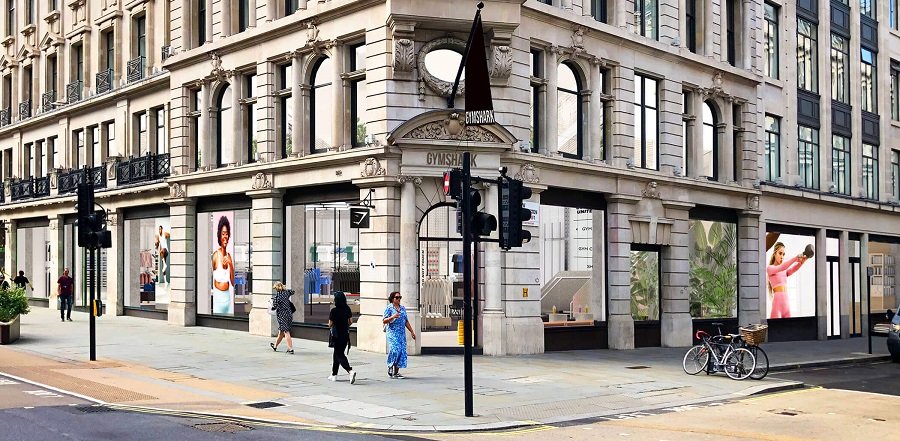Setting up shop
UK high streets and shopping malls came back to life in 2022, with momentum continuing into 2023.
But as shoppers returned to stores there was a 26% decrease in internet sales in 2022 (as a percentage of total sales). This led to many online brands opening physical stores such as premium workout apparel brand Gymshark who recently opened their flagship store on Regent Street in London (seen above).
Many factors are to be considered when deciding to open a physical store. We look at the key considerations in deciding between shopping centres (aka malls outside the UK) or high streets:
Shopping centres
Shopping centres have many advantages over high streets. Firstly, they often offer more consistent footfall and revenue, as they are less affected by seasonal fluctuations or changes in consumer behaviour due to their wider offer. This is why established brands with strong margins often favour shopping centres when trying to scale up their number of stores. Shopping centres also offer more amenities and facilities for customers, such as parking, food courts, toilets, seating and entertainment options. The main anchor are often strong footfall generators such as leisure and entertainment activities or big names such as M&S or John Lewis.
It is also important to consider other operators within the shopping centre depending on how your brand is positioned within the market (mid-market, premium, luxury) to avoid alienating your store and catering to the wrong audience. In addition, based on our experience, each level higher in a shopping centre experiences a reduction in footfall and sales densities from the ground floor by roughly 60% to 75%. Placing stores on higher levels would be ideal for F&B, service, and leisure operators.
Another important factor to bear in mind for shopping centres is the additional costs and restrictions. They may be subject to higher service charges, which can add to the overall cost of running a store. Furthermore, spaces are often subject to longer leases and stricter lease agreements, which can limit flexibility and require a longer-term commitment. Retailers may also be subject to certain restrictions on design and branding which can limit the ability to create a unique store identity. Hence, it is not ideal for newer brands who are focused on brand exposure through their store experience.
High streets
Compared to shopping centres, high street stores often have better visibility and higher levels of footfall as they are located on busy streets in town centres. However, high street stores may be subject to a higher level of competition from neighbouring shops, which could affect footfall and revenue. High street stores are often unique and individual, with character that can appeal to customers looking for something different.
This provides brands a good opportunity to showcase their identity and differentiate themselves. High street stores are usually more expensive to rent than shopping centre spaces due to their prime location and can require significant upfront costs for refurbishment and fitting out but offer more flexibility in terms of lease agreements, with shorter-term leases and more room for negotiation.
As the retail market evolves, investment in enhanced store frontages and interior fitout is becoming crucial to capture the attention of younger generation shoppers. Trends such as in store activation through digital frontages, implementing nature to create a relaxing environment or spaces to host classes and seminars are becoming increasingly popular to enhance customer experiences and brand awareness.
Ultimately, the decision of whether to open a store on the high street or in a shopping centre/mall begins with understanding consumer behaviour by location and how it will impact your performance and profitability.
Mukhriz Mustamir

